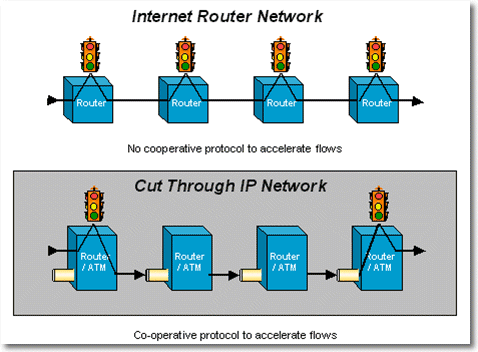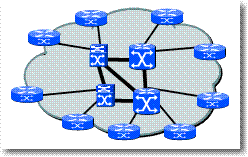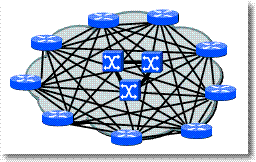Networks Part 2: The phenomenon of Ipsilon
February 2007
 You don't read this sort of
review about a start-up too often do you?
You don't read this sort of
review about a start-up too often do you?
"A year ago, they were the Beatles. When Ipsilon Networks, Inc. touched down in March 1996, it whipped the industry into a frenzy with its hooky melodies and breezy harmonies on IP switching. Ipsilon's chart-busters included tunes on establishing cut-through IP routes over ATM, snubbing complex routing dogma from standards groups, and divorcing enterprise nets from the self-centered Cisco Systems, Inc.
The industry was transformed into a screaming, blubbering mess, tearing its locks out pleading for more, more IP switching. But that was yesterday. Today, Ipsilon is but a nostalgic footnote... " This quote was from Nokia catches a falling Ipsilon by Jim Duffy Network World, 12/9/97."
Phew! I first came across Ipsilon one wet winter's morning in 1996 I think. I can't quite remember which newspaper it was in, but there was this small 3" column on the right-hand side of the page that talked about a revolution in networking - such a headline would always catch my eye!
I immediately added them to my list of companies that I wanted to visit the next time I was in Silicon Valley. I did, and what I heard changed many of my views. So just what was so seminal about Ipsilon that caused all the frenzy?
One of the key strengths of the Internet Protocol (IP) was that it was resilient. If a particular node or router had problems, packets would find an alternative path to their destination if there was one to be found. In fact, this was the core capability of the routing algorithms that were used to move IP packets around a network. OSPF (Open Shortest Path First) was the most common routing protocol developed for IP networks and it was based on finding and using the shortest path first.
However, this algorithmic approach although having many benefits, was flawed in a particular area that remains with us even today. The flaw was that it was possible for individual packets in a particular packet stream to take different routes between the source and the destination depending on congestion. For downloads based on TCP/IP this did not particularly matter as the packets could be reconstituted into the correct sequence no matter in which order they were received.
BUT, this causes a major problem for real-time services such as voice over IP (VoIP) or interactive video conferencing where latency beyond, say 200mS, causes a noticeable hesitation which significantly affects the quality of conversations. Having to wait around for all the packets to arrive and reorder them could add significant latency. We all have heard this effect when using services such as Skype.
Another issue behind Ipsilon was that IP routers at the time were very expensive. As ATM was seen as the next dominant technology at the time, every man and his dog were producing ATM switches. In reality, ATM was not seeing the enterprise uptake expected by the vendor industry, price wars broke out and ATM switches became available at reasonable costs.
The light that went on in the Ipsilon founders' brains was that if they could embed enhanced routing software on generic ATM switch hardware, they would have a competitively costed router that would use ATM functionality to provide, what they called, cut through routing or IP Switching as shown below in one of Ipsilon�s presentations.
This involved taking off-the-shelf ATM switches, throwing all the ATM software away and replacing it with enhanced routing software. What this meant in practice was that the only bit of ATM that remained was the physical switch fabric and the ability to set up a virtual connection from one end of the network to another so that data can be transmitted in one hop only.

Ipsilon's vision for 'cut through' routing.
To quote Mary Petrosky from 1998:
�Although the ATM Forum had been working on a short-cut routing solution called Multiprotocol Over ATM for some time, Ipsilon Networks catalyzed the industry in the spring of 1996 with the announcement of its scheme, dubbed IP switching. By exploiting ATM switching hardware with a new set of IP-oriented protocols, Ipsilon promised to deliver millions of packets-per-second throughput, compared to the forwarding rate of hundreds of thousands of packets per second supported by the current generation of routers.�
 This was really magic stuff and went
right against the core Internet philosophy of the time which focused on what was known as connectionless routing. i.e. a packet would be dumped into the network and it would follow whatever
path it could to reach its destination. Engineers that supported this approach were colloquially called 'netheads'.
This was really magic stuff and went
right against the core Internet philosophy of the time which focused on what was known as connectionless routing. i.e. a packet would be dumped into the network and it would follow whatever
path it could to reach its destination. Engineers that supported this approach were colloquially called 'netheads'.
Whereas exponents of cut-through routing followed the routing principles of the Public Switched Telephone Network (PSTN). Here, a path between network (domain) ingress and egress was set up prior to sending the packets into the network which is called deterministic routing. Of course, exponents of this approach were enevitably called 'bellheads'. It sometimes felt that there was outright war between these two factions! In fact both were right in their own way.
Deterministic routing is crucial to obtaining sufficient Quality of Service for real-time services and the insight provided by Ipsilon turned the industry on its head. One of the early pre-MPLS IETF standards Transmission of Flow labelled IPV4 on ATM networks, drafted by Ipsilon, makes an interesting read.
Although I do not know (more likely can't remember!) all the industry inside stories, it was clear that this concept was not foreseen by Cisco or any of the other big equipment vendors of the time.
You can read the full story of Ipsilon in the article linked above, but sadly Ipsilon failed as a company due to insufficient sales and were sold to Nokia in 1997. To quote Nokia�s press release:
�Nokia will acquire Ipsilon Networks, Inc., on December 9th, 1997, a data communications company based in Sunnyvale, California, US, for approximately USD 120 million, subject to regulatory approval expected by end of the year�Ipsilon Networks is a leading innovator in the development of open Internet Protocol (IP) routing platforms.�
To quote David Passmore:
�Ipsilon also discovered that shortly after turning everyone on to IP switching, Cisco froze the market with Tag Switching and Multi-protocol Label Switching."
"It's obvious that Ipsilon basically failed in their mission to establish IP switching," Quite frankly, the whole cut-through routing technique embodied by IP switching, 3Com FastIP and Cabletron's SecureFast doesn�t make sense anymore in this era of gigabit, wire-speed routers."
Once the cut-through routing idea hit the market, all the major IP equipment vendors jumped on the bandwagon. In particular, Cisco announced proprietary Tag switching (which was rumoured to be a an Ipsilon killer and, if so, succeeded in that ambition) which eventually morphed into the IETF�s Multiprotocol label switching (MPLS) standards still in use today.
Ipsilon was a seminal start-up in networking that transformed the industry and had a completely unique approach to market. It had so much going for it, but maybe being #1 with an idea is not always a good position to be in � especially when your competitor is a behemoth such as Cisco! My view is that they were just well ahead of of their time and trying to re-educate the world is just too much of a challenge when all thier backers wanted was sales.
To finish, Dave Passmore made an extremely pertinent point back in 1997 that could be just as applicable today: �[IP switching] doesn�t make sense anymore in this era of gigabit, wire-speed routers." More about this later.

